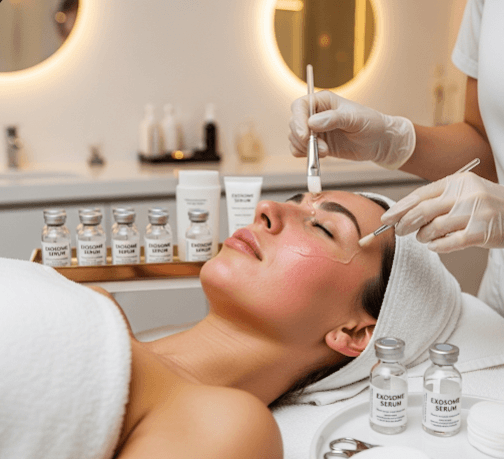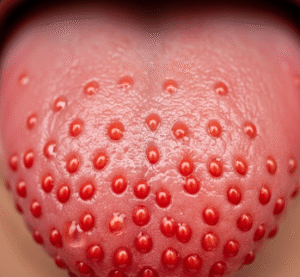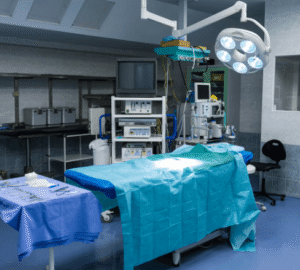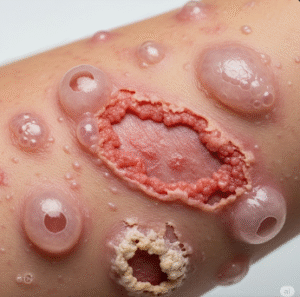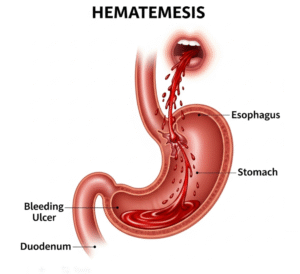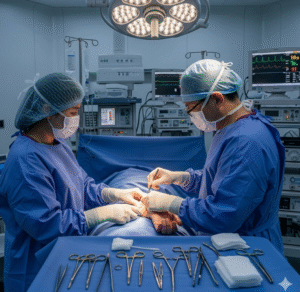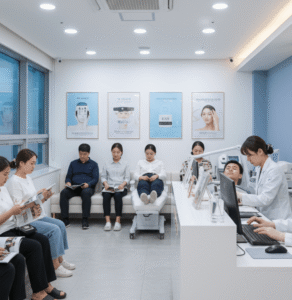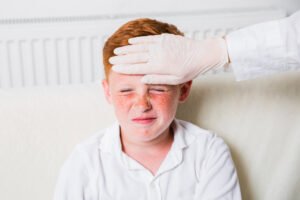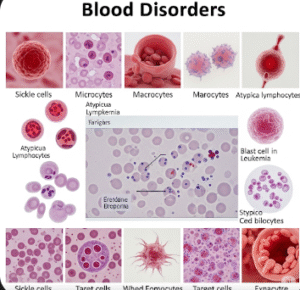What It Is
Exosome Facial Therapy is an advanced regenerative skincare treatment that uses exosomes, which are tiny extracellular vesicles secreted by stem cells. These vesicles carry growth factors, peptides, proteins, and genetic material that signal skin cells to regenerate, repair, and restore balance.
Think of exosomes as messengers for skin rejuvenation. They communicate with cells to stimulate collagen and elastin production, reduce inflammation, and speed up healing. The result is firmer, clearer, and more radiant skin.
While exosome therapy is becoming popular worldwide, in Korea it has already become a flagship part of skin rejuvenation programs, often paired with microneedling, RF treatments, or lasers to maximize their penetration and effectiveness.
Why It’s Done
Exosome facial therapy is sought after because it targets multiple skin issues at once:
➝ Anti-aging benefits: Reduces fine lines, wrinkles, and skin sagging.
➝ Skin healing: Accelerates repair of acne scars, pigmentation, and sun damage.
➝ Boosted hydration: Strengthens the skin barrier for smoother, plumper skin.
➝ Inflammation control: Calms rosacea, redness, or post-treatment irritation.
➝ Faster recovery: Commonly used after lasers or microneedling to shorten downtime.
➝ Preventative skincare: Younger patients use it to maintain firm, resilient, and “glass-like” skin.
In Korea, this treatment aligns perfectly with the cultural standard of “yurial pibu” (glass skin) — skin that looks flawless, luminous, and youthful.
Alternatives
If exosome therapy is not chosen, alternatives include:
- PRP (Platelet-Rich Plasma) → Uses the patient’s own platelets for regeneration.
- Rejuran Healer (PN/PNN injections) → Polynucleotides from salmon DNA that repair and strengthen skin.
- Mesotherapy / Skin Boosters → Deliver hydration and nutrients into the skin.
- Stem cell therapy → Uses stem cells directly but is more invasive and costly.
- Chemical peels or facials → Improve brightness but lack strong regenerative effects.
In Korean clinics, exosomes are often positioned as a next-generation upgrade to PRP and Rejuran, offering stronger anti-aging and healing effects with faster results.
Preparation
Proper preparation ensures the best outcome:
➝ Consultation & skin analysis → Doctors assess elasticity, hydration, and problem areas with 3D scans.
➝ Medical review → Patients disclose medications, allergies, and conditions.
➝ Skincare pause → Retinoids, exfoliating acids, or harsh products are stopped 5–7 days before.
➝ Lifestyle prep → No alcohol or smoking for 48 hours prior.
➝ Hydration → Drinking plenty of water enhances recovery.
➝ Sun avoidance → No tanning or excessive sun exposure for at least 2–3 weeks.
In Korea, many clinics also include a hydrating facial or calming mask before treatment so the skin is in prime condition for absorbing exosomes.
How It’s Done
The procedure is simple, safe, and usually lasts 45–60 minutes:
- Deep cleansing → Removes oils, dirt, and makeup.
- Microchannel preparation → Microneedling, light laser, or RF creates pathways in the skin.
- Exosome application → A serum containing exosomes is applied or injected.
- Absorption boost → Cooling masks, ultrasound, or LED therapy help push exosomes deeper.
- Final hydration → Soothing serums and SPF are applied.
Treatment plan:
- Initial sessions → 3–5 treatments, spaced 3–4 weeks apart.
- Maintenance → 1 session every 6 months for lasting results.
Recovery
Exosome therapy has minimal downtime, making it popular among busy professionals:
- Day 1–2: Mild redness or slight swelling (if microneedling was used).
- Day 3–5: Skin feels firmer, brighter, and more hydrated.
- Week 1–2: Noticeable improvements in tone and texture.
- Month 2–3: Collagen stimulation peaks, reducing fine lines and scars.
Aftercare in Korea typically includes:
➝ Daily use of SPF 50+.
➝ Avoiding makeup for 24 hours.
➝ Using only gentle, hydrating cleansers and creams.
➝ Skipping saunas, alcohol, and intense exercise for 2 days.
Many Korean clinics provide aftercare kits with calming creams, sheet masks, or even free LED sessions to support recovery.
Complications
Exosome therapy is very safe, but potential side effects include:
➝ Mild redness or swelling → Usually gone within 1–2 days.
➝ Bruising → If injections or microneedling are used.
➝ Temporary dryness or flaking → As skin renews.
➝ Allergic reactions → Extremely rare, since exosomes are biocompatible.
➝ Infection → Rare if proper sterile techniques are followed.
Korean clinics minimize risks by using medical-grade exosome products, advanced devices, and precise techniques.
Treatment Options in Korea
South Korea is a leader in exosome-based regenerative skincare, offering cutting-edge therapies.
1. Different delivery methods
- Topical facials → Infusion with massage or oxygen therapy.
- Microneedling with exosomes → Ensures deeper absorption.
- RF + exosome combos → Tightening and regeneration in one session.
- Injectable exosomes → Targeted therapy for scars or wrinkles.
Final Thoughts
Exosome Facial Therapy in Korea represents a major step forward in regenerative skincare. Unlike fillers or Botox, which target isolated problems, exosomes improve overall skin health at the cellular level, enhancing repair, collagen production, and hydration simultaneously.
Korea’s expertise in dermatology, paired with cutting-edge biotech research, makes it one of the world’s best destinations for exosome therapy. For anyone wanting youthful, glowing, and resilient skin, this treatment provides a natural yet highly effective solution.

